Rohan Jain
Sparse Training from Random Initialization: Aligning Lottery Ticket Masks using Weight Symmetry
May 08, 2025Abstract:The Lottery Ticket Hypothesis (LTH) suggests there exists a sparse LTH mask and weights that achieve the same generalization performance as the dense model while using significantly fewer parameters. However, finding a LTH solution is computationally expensive, and a LTH sparsity mask does not generalize to other random weight initializations. Recent work has suggested that neural networks trained from random initialization find solutions within the same basin modulo permutation, and proposes a method to align trained models within the same loss basin. We hypothesize that misalignment of basins is the reason why LTH masks do not generalize to new random initializations and propose permuting the LTH mask to align with the new optimization basin when performing sparse training from a different random init. We empirically show a significant increase in generalization when sparse training from random initialization with the permuted mask as compared to using the non-permuted LTH mask, on multiple datasets (CIFAR-10, CIFAR-100 and ImageNet) and models (VGG11, ResNet20 and ResNet50).
Gemini 1.5: Unlocking multimodal understanding across millions of tokens of context
Mar 08, 2024Abstract:In this report, we present the latest model of the Gemini family, Gemini 1.5 Pro, a highly compute-efficient multimodal mixture-of-experts model capable of recalling and reasoning over fine-grained information from millions of tokens of context, including multiple long documents and hours of video and audio. Gemini 1.5 Pro achieves near-perfect recall on long-context retrieval tasks across modalities, improves the state-of-the-art in long-document QA, long-video QA and long-context ASR, and matches or surpasses Gemini 1.0 Ultra's state-of-the-art performance across a broad set of benchmarks. Studying the limits of Gemini 1.5 Pro's long-context ability, we find continued improvement in next-token prediction and near-perfect retrieval (>99%) up to at least 10M tokens, a generational leap over existing models such as Claude 2.1 (200k) and GPT-4 Turbo (128k). Finally, we highlight surprising new capabilities of large language models at the frontier; when given a grammar manual for Kalamang, a language with fewer than 200 speakers worldwide, the model learns to translate English to Kalamang at a similar level to a person who learned from the same content.
EROS: Entity-Driven Controlled Policy Document Summarization
Feb 29, 2024


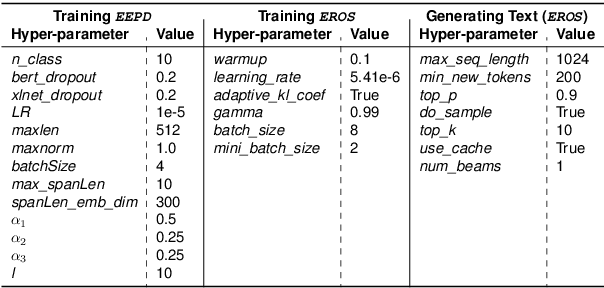
Abstract:Privacy policy documents have a crucial role in educating individuals about the collection, usage, and protection of users' personal data by organizations. However, they are notorious for their lengthy, complex, and convoluted language especially involving privacy-related entities. Hence, they pose a significant challenge to users who attempt to comprehend organization's data usage policy. In this paper, we propose to enhance the interpretability and readability of policy documents by using controlled abstractive summarization -- we enforce the generated summaries to include critical privacy-related entities (e.g., data and medium) and organization's rationale (e.g.,target and reason) in collecting those entities. To achieve this, we develop PD-Sum, a policy-document summarization dataset with marked privacy-related entity labels. Our proposed model, EROS, identifies critical entities through a span-based entity extraction model and employs them to control the information content of the summaries using proximal policy optimization (PPO). Comparison shows encouraging improvement over various baselines. Furthermore, we furnish qualitative and human evaluations to establish the efficacy of EROS.
Gemini: A Family of Highly Capable Multimodal Models
Dec 19, 2023Abstract:This report introduces a new family of multimodal models, Gemini, that exhibit remarkable capabilities across image, audio, video, and text understanding. The Gemini family consists of Ultra, Pro, and Nano sizes, suitable for applications ranging from complex reasoning tasks to on-device memory-constrained use-cases. Evaluation on a broad range of benchmarks shows that our most-capable Gemini Ultra model advances the state of the art in 30 of 32 of these benchmarks - notably being the first model to achieve human-expert performance on the well-studied exam benchmark MMLU, and improving the state of the art in every one of the 20 multimodal benchmarks we examined. We believe that the new capabilities of Gemini models in cross-modal reasoning and language understanding will enable a wide variety of use cases and we discuss our approach toward deploying them responsibly to users.
Towards One Shot Search Space Poisoning in Neural Architecture Search
Nov 13, 2021


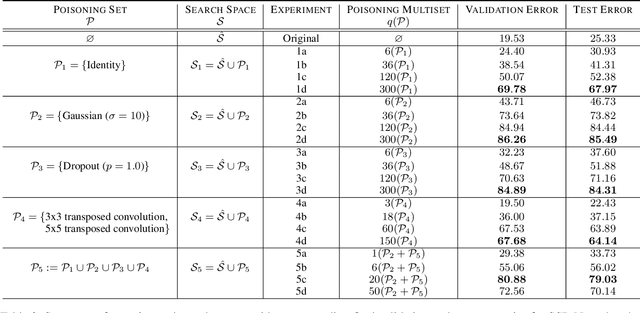
Abstract:We evaluate the robustness of a Neural Architecture Search (NAS) algorithm known as Efficient NAS (ENAS) against data agnostic poisoning attacks on the original search space with carefully designed ineffective operations. We empirically demonstrate how our one shot search space poisoning approach exploits design flaws in the ENAS controller to degrade predictive performance on classification tasks. With just two poisoning operations injected into the search space, we inflate prediction error rates for child networks upto 90% on the CIFAR-10 dataset.
NeuralArTS: Structuring Neural Architecture Search with Type Theory
Nov 05, 2021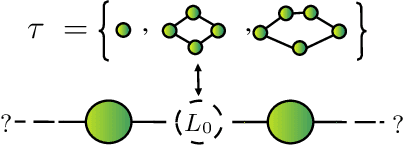


Abstract:Neural Architecture Search (NAS) algorithms automate the task of finding optimal deep learning architectures given an initial search space of possible operations. Developing these search spaces is usually a manual affair with pre-optimized search spaces being more efficient, rather than searching from scratch. In this paper we present a new framework called Neural Architecture Type System (NeuralArTS) that categorizes the infinite set of network operations in a structured type system. We further demonstrate how NeuralArTS can be applied to convolutional layers and propose several future directions.
Poisoning the Search Space in Neural Architecture Search
Jun 28, 2021
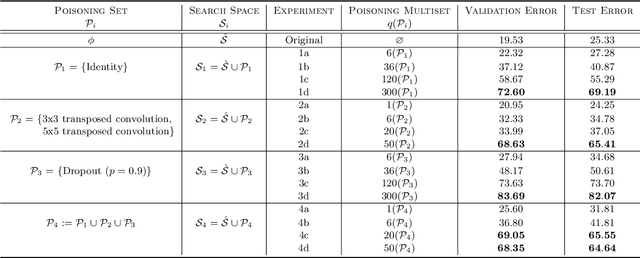
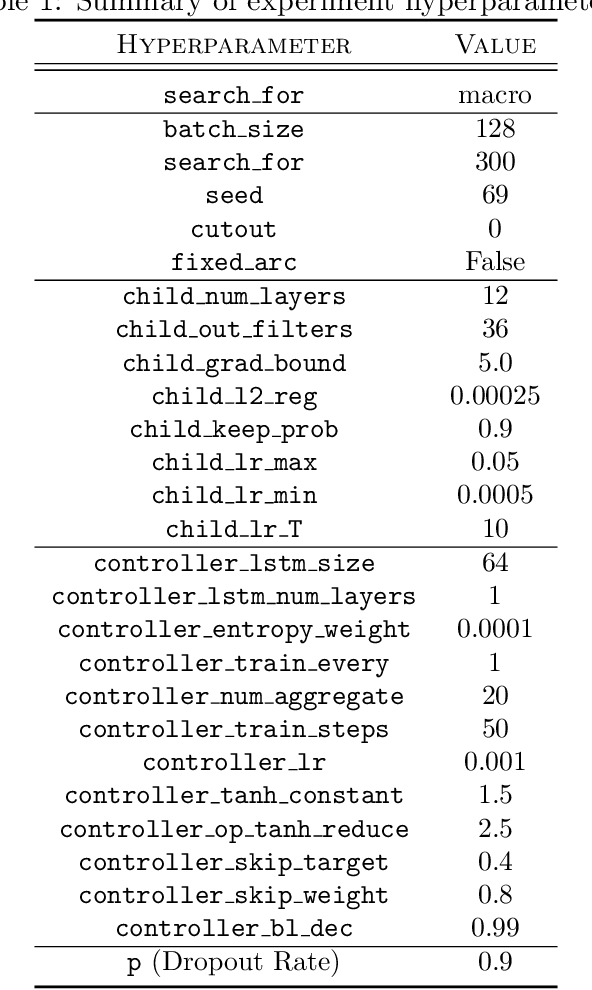
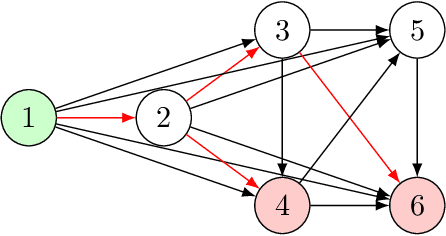
Abstract:Deep learning has proven to be a highly effective problem-solving tool for object detection and image segmentation across various domains such as healthcare and autonomous driving. At the heart of this performance lies neural architecture design which relies heavily on domain knowledge and prior experience on the researchers' behalf. More recently, this process of finding the most optimal architectures, given an initial search space of possible operations, was automated by Neural Architecture Search (NAS). In this paper, we evaluate the robustness of one such algorithm known as Efficient NAS (ENAS) against data agnostic poisoning attacks on the original search space with carefully designed ineffective operations. By evaluating algorithm performance on the CIFAR-10 dataset, we empirically demonstrate how our novel search space poisoning (SSP) approach and multiple-instance poisoning attacks exploit design flaws in the ENAS controller to result in inflated prediction error rates for child networks. Our results provide insights into the challenges to surmount in using NAS for more adversarially robust architecture search.
 Add to Chrome
Add to Chrome Add to Firefox
Add to Firefox Add to Edge
Add to Edge